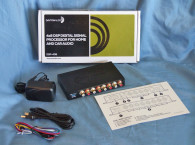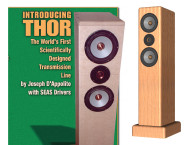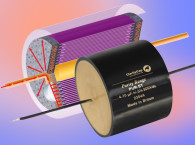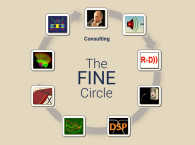
Gotta Have ‘Em!
I have a neighbor, Jerry, who owns a pair of L300s he acquired in the early 1980s. He was using them for the back channels in his media room. You might ask, “What speakers would relegate L300s to the back channels?” A custom pair of Augspurger monitors using dual TAD 1601 woofers, bi-amped with TAD 4001 compression drivers and horns. Very nice.
Jerry’s L300s had spent a lot of time exposed to Los Angeles, CA, sunshine and smog. The result being that the woofer surrounds had decomposed, as had the grill cloth material, and the wood had become dried and bleached. Nevertheless, they rekindled my original lust for these pieces, and I decided to get a pair. Kent English found them for sale in San Francisco at the corner of Haight and Ashbury.
They were in excellent shape. The wood looked good and the woofer cones had new foam surrounds. Jake played me a few cuts to confirm proper operation, and yes, they were as I remembered them, warts and all. I hauled them home and over the course of several weeks the efficient bass reflex boxes and horns provided a nice manly contrast to my full-range cones in open baffles.
On the positive, the sound is very dynamic and lively, with punchy bass and good articulation coming from the mid-range and top-end horns. Very rock and roll.
Another plus is that they are easier to drive than I had been led to believe. They seem to work well with low-power amplifiers and with amplifiers without high damping factors. Toward this end, they are good candidates for tube amplification. And they come with level controls, allowing adjustment of midrange and tweeter levels so you can tweak them to taste.
I suppose it’s too much to ask for perfection from speakers introduced at the beginning of the Disco era. The faults are two: the bass bump at 50 Hz is a bit resonant, and the crossover network between the woofer and midrange brings out too much of the “horn sound” in the system.
Perhaps it’s just that tastes have evolved over 36 years, or perhaps it’s just me, but after a while these traits began to wear on me, and I began thinking about some adjustments.
By the way, George Brooke did a nice write up on renovating his L300’s, and you can check that out in the September 2001 issue of audioXpress. His piece is not marred by the inclusion of an Aleph 5 power amplifier, and I am informed he is considering another article featuring the JBL 4343.

New Woofer Surrounds
Meanwhile, Jerry climbed on board to renovate his pair of L300s. In his case, we needed to repair the surrounds on his woofers, so we went to Orange County Sound (www.speakerrepair.com) and ordered up some re-edge kits #11-035-WJBL for $30. For those who view this sort of task with trepidation, these folks also offer a service to do it for you. We opted for the DIY kit, on the logic that the worst that could happen is that we would end up sending them to Orange County anyway.
The kit turned out to be perfect. We trimmed off the decayed foam surrounds with a sharp hobby knife, scraping the old adhesive from the cone and the cast basket.
The new foam edges and the gaskets fit perfectly, and we first glued the cones to the surrounds and then came back the next day to fit these to the rim of the baskets.
Fortunately, Orange County Sound provides a generous quantity of the glue, and by following the instructions it came out perfectly.
The Original Crossover
I opened up the speakers and removed the crossover network to the outside, running wires through the bass port to the drivers. Then, I made a series of measurements documenting its characteristics, plotting the voltages to the drivers, the impedance seen by the amplifier and the acoustic response. I also measured the raw impedances of each driver so that I could better simulate their interaction with a crossover network.
Figure 1 shows the original crossover schematic as provided by JBL.
Figure 2 illustrates a plot of the voltages fed to the drivers vs. frequency.
Here you see the curve of both speakers, and we infer that the crossover points are about 1 kHz between woofer and midrange, and about 7 kHz between midrange and tweeter.
Figure 3 is a plot of the acoustic output of the speaker at one meter. The dip you see here at 400 Hz is a floorbounce artifact, but the dip at 1700 Hz is the response of the speaker. Figure 4 is an impedance plot seen by the amplifier.



Another Take on the Crossover
After I measured the stock crossover, I began to assemble a new one from scratch, wiring prospective components on a piece of plywood sitting on top of the speaker.
I set up the system so that I could easily listen and also measure electrical and acoustic response.
This started a process that lasted several months. Some of you might imagine that we can just plug the measured numbers into the computer and it will spit out a perfect crossover network.
Certainly, it will spit out something, but it is unusual for the results to be the best possible sound. At best, the simulations will give you a good start.
Of course, we already had a good starting point by virtue of the original design. Also there are a couple of other alternative designs on the web, testaments to the respect the L300 gets in polite audio society.
The revision procedure involves trying something, measuring, and then listening a lot. With a soldering iron and lots of parts handy, the first two parts only take a few minutes. The last part is occasionally quick (when it sounds awful). If it sounds good or better, then it is necessary to spend more time with it, running through a series of familiar recordings, sometimes for days, deciding on whether the change stays or not.
And then you reiterate the process until you are happy with the sound and every change you make sounds worse. I usually use CDs for this as it can be very hard on my precious vinyl. In the early 1970s at ESS, we kept boxes of Oscar Peterson, Joan Baez, and the soundtrack from Shaft, not to mention spare cartridges,
and we tended to burn through them.

As I said earlier, there were two performance issues. The first was the resonant bass bump at about 50 Hz, which turned out to be easy enough to deal with—small amount of dacron in the port. This reduced the bump by about 3 dB at the 50-Hz point, tightening and smoothing the sound. You can conveniently adjust this to taste from the outside.
The character of the woofer to midrange transition was more difficult. Looking at the curves and schematic, I made a guess that the original design had to contend with the prospect of being driven to very high-power levels. This is a potential problem concerning both the distortion and reliability of the midrange compression driver, as this horn does not provide much loading below 1 kHz. The crossover network addresses this with a relatively high-crossover point at 1 kHz, with a fairly sharp slope. A similar approach is used in the crossover characteristic between the midrange and the horn tweeter, with the high-pass filter having three poles.
My reasoning was that given the expectation of more modest power levels we could relax these constraints, lowering the crossover point and using filters with a lower “Q.” Toward that end, I began constructing variations of the original filter set to examine whether going in that direction improved the sound.
After a while, I settled into a woofer low-pass network that was nearly identical to the original, except with a slightly lower frequency. I used heavy-gauge air core coils over iron core, and larger value polypropylene capacitors, both presumably better than the original parts.

Initially, I worked with variations around the original in-phase wiring of the midrange, but I found it difficult to construct a filter that was flat at 1 kHz and also sounded as good as I wanted. I think the difficulty revolved around the distance time delay of the midrange, which can be clearly seen in a MLSSA pulse. (That is to say, there are two of them: one from the woofer and tweeter and another from the midrange.) Finally, I began working with the midrange phase flipped.
This is where I had to choose between faults. There is simply not an ideal complementary match between the character of these two drivers. After some more experimenting, I worked up my best compromise—a midrange high-pass network, which is different in the details and response curve, but delivers most of the warmth, intimacy and articulation I was looking for. This is where the instruments have a “float in the air quality” that takes the performance out of the box and into your room.
Very often you get something like this simply by trying everything, and in the end, depending on your ears to tell you when it’s right. I continued playing with variations for several weeks, but kept coming back to this circuit (see Figure 5).
All the coils are heavy gauge air core, the capacitors are polypropylene and the resistors are 10 W. Where you see parallel resistors is where I wanted 20 W. You can get these from Parts Express or Madisound. Clarity Caps and Mills resistors were chosen because they were on hand. All the parts were glued down with silicone adhesive and wired point-to-point.
High precision is not essential in this network — 5% is plenty good enough. No fancy wire was used in the speaker, just the regular stuff from National Cable, but with separate lines from the crossover elements to the input terminals to minimize interaction.
Also when considering where to glue the coils on the plywood board, keep them some distance apart so they don’t talk to each other. The 12” × 16” piece of wood has plenty of space and still fits on the bottom of the enclosure fine.
I replaced the input terminals with big fat gold ones and kept the L-pads in the circuit (mostly to keep the controls on the front panel).
You can replace the originals with these parts from Parts Express:
• Tweeter: #260-250 8 Ω 15-W Lpad
• Midrange: #260-265 8 Ω 100-W Lpad
Make a point of getting the 1”-long shafts, as the boards that holds these inside the enclosure recesses them, and you want to have the original knobs sit flush with the front baffle.
Many people look askance at L-pads. This is understandable, and the wipers are certain to get noisy over the years. Some people think they just sound lousy anyway, but I did, in fact, use them satisfactorily. If you want to do better, here is an alternative network using resistors tapped to discrete levels (see Figure 6).

This network was tested, and the performance differences between it and the L pad were minimal, so you can use it without compromise. Just attach the driver’s wire to tap points from Low to High as you like. The resistors can be 3 W or more, and once again, 5% is plenty of precision. The sound didn’t suffer for using wire-wound types, but if you want to pay more for noninductive resistors you should feel free.
Refer to Figure 7 for the response curve of this crossover network.
Comparison between this and the original shows that the roll-off characteristic for the drivers is similar, but less sharp. The crossover frequency between the woofer and the midrange has been moved down slightly, and the tweeter is now crossed slightly higher, but with a single pole (one capacitor) instead of the original three-pole network.


Figure 8 shows a smoothed nearfield curve of the woofer to midrange response. The above curve has been smoothed to highlight the acoustic center of the crossover point, which is about 700 Hz. Of course, the real curve is bumpier than this, reflecting the resonant points of the horn midrange and some interference between the drivers. For the acoustic response of the speaker at 1 m refer to Figure 9.
Here you can see more of the vagaries of the actual response. At 300 Hz, we observe some interference off the floor (not such a problem at greater distances from the speaker) and the bumps and dips of the crossover point itself. What can I say? I can make it flatter, but I can’t make it sound better. Also, here you can see the addition of the tweeter to the system where the curve bifurcates above 6 kHz. Figure 10 shows the input impedance of the modified speaker.


Ideal For DIY Efforts
This isn’t the first time I have tried to improve a JBL loudspeaker. Some years ago I played with a pair of L100s (love that grill), but I have to say that I could not regard that as a success. Most likely, I simply didn’t put enough time and effort into them. I did learn that it is not a trivial task to improve on original JBL design. If it can be done at all, it requires a lot of persistence and patience — just the kind of approach Thomas Edison would have used.
The speaker is very forgiving of amplifiers. I was able to drive them well with 600-W mono-blocks with high damping factors and also with little 5-W amplifiers having damping factors of three or four. Both extremes worked well, even if the sound was not quite identical.
I am very happy with the results. The end product doesn’t appear to be an improvement based on response curves alone, but they do sound really great. I think I’ve managed to respect the JBL legacy while tweaking the sound to reflect the tastes of the 21st century. They still have that lively character of the originals, but the bass thumps are a little tighter and the horns a little more subtle and sweet, inviting you to spend hour after hour going through your entire record collection, which is what we’re here for.
And, of course, I kept the original crossovers.
Article originally published in audioXpress, January 2012





